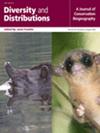How Do Species Traits and Biogeographical Factors Determine the Fate of Amphibians After Long-Term Fragmentation?
Abstract
Aim
Identifying key factors that render certain species more vulnerable to fragmentation is vital for elucidating processes underlying extinction and targeting conservation priorities. However, few studies have explored the delayed ecological responses of species following isolation. To bridge the gap, we conducted comprehensive analyses of correlates of extinction vulnerability and biogeographical variation in amphibians over long-term fragmentation.
Location
Zhoushan Archipelago, China.
Methods
We sampled the occupancy of amphibians on 37 land-bridge islands. We calculated three metrics of extinction vulnerability (population extinction rate, island occupancy frequency and species nestedness ranking) for each species and correlated these variables with eight species' traits. We further explored biogeographical variations in amphibians by relating five biogeographical variables to species' probability of occurrence and calculated the threshold for the persistence of each species on islands.
Results
Species with low natural abundance, larger egg sizes, smaller clutch sizes or restricted geographical distributions were more likely to experience higher population extinction rates and species nestedness rankings, while lower island occupancy frequencies across islands. Although most species were found on larger islands, we observed significant increases in the occurrence probabilities with island area for five species. The estimated areas with a 50% chance of occurrence ranged from 0.39 to 199.5 km2. Interestingly, the likelihood of occurrence of Hyla chinensis (treefrog) was negatively related to distance to the mainland after controlling for the effect of area.
Main Conclusions
Our study highlights the variation in the fragmentation sensitivity of amphibians. Species distribution was primarily regulated by area-related extinction, particularly for those with ‘slow’ life history strategies or restricted ranges. Overall, management efforts should focus on species with extinction-prone traits and landscape features that threaten the persistence of populations. Future studies should consider the sequential separation of island populations and the interaction of traits to reveal the fate of species to fragmentation.


 求助内容:
求助内容: 应助结果提醒方式:
应助结果提醒方式:


